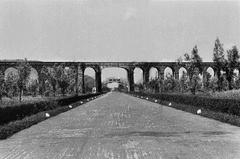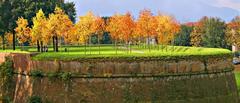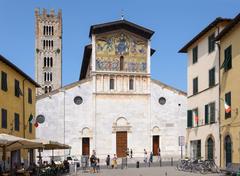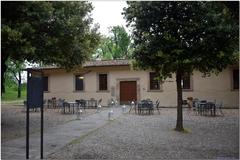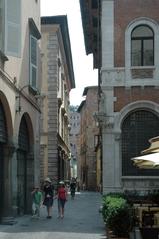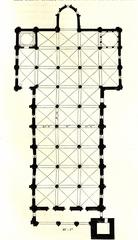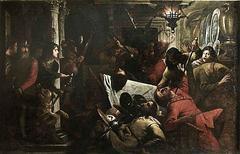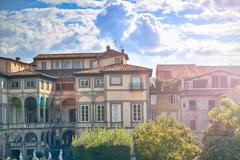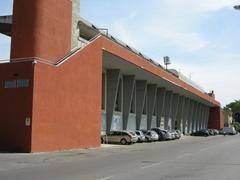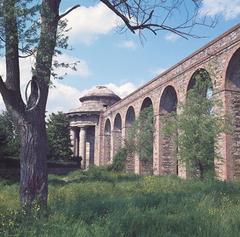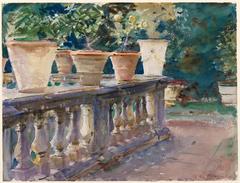Visiting Hours, Tickets, and Historical Significance of Porta Santi Gervasio e Protasio, Lucca
Date: 23/07/2024
Introduction
Porta Santi Gervasio e Protasio, commonly referred to as Porta San Gervasio, is an iconic historical gate situated in the medieval walls of Lucca, Italy. Constructed in 1198, this gate is a significant part of the city’s rich architectural and cultural heritage. As one of the primary entry points into Lucca during the medieval era, Porta San Gervasio played a crucial role in the city’s defense and commerce due to its strategic location along the Via Francigena, a major pilgrimage route to Rome (Via Francigena). The gate’s dedication to Saints Gervasius and Protasius, early Christian martyrs, underscores the intertwining of religious significance with civic identity in medieval Lucca (Catholic Saints). Today, Porta San Gervasio stands as a testament to the city’s resilience and historical importance, attracting visitors eager to explore its architectural marvels and cultural significance.
Table of Contents
- [Introduction](#introductionintroduction)
- [Historical Background](#historical-backgroundhistorical-background)
- [Origins and Construction](#origins-and-constructionorigins-and-construction)
- [Architectural Features](#architectural-featuresarchitectural-features)
- [Historical Significance](#historical-significancehistorical-significance)
- [Restoration and Preservation](#restoration-and-preservationrestoration-and-preservation)
- [Cultural and Symbolic Importance](#cultural-and-symbolic-importancecultural-and-symbolic-importance)
- [Visitor Information](#visitor-informationvisitor-information)
- [Ticket Prices and Opening Hours](#ticket-prices-and-opening-hoursticket-prices-and-opening-hours)
- [Travel Tips](#travel-tipstravel-tips)
- [Nearby Attractions](#nearby-attractionsnearby-attractions)
- [Preservation Challenges](#preservation-challengespreservation-challenges)
- [Educational and Research Opportunities](#educational-and-research-opportunitieseducational-and-research-opportunities)
- [FAQ](#faqfaq)
- [Conclusion](#conclusionconclusion)
Historical Background
Origins and Construction
Porta Santi Gervasio e Protasio, also known as Porta San Gervasio, is one of the historic gates of the medieval city walls of Lucca, Italy. It was constructed in 1198 during a period of significant urban expansion and fortification (Lucca Walls). The construction of the gate was part of a broader effort to enhance the city’s defenses and control access, reflecting the strategic importance of Lucca during the Middle Ages.
Architectural Features
The architectural design of Porta San Gervasio is a testament to the medieval military engineering of the time. The gate features a robust, rectangular structure with a central archway flanked by two imposing towers. These towers were designed to provide a vantage point for guards and archers, ensuring the gate could be defended against potential invaders. The use of local stone and brick in the construction highlights the regional building materials and techniques of the era (Medieval Architecture).
Historical Significance
Porta San Gervasio played a crucial role in the defense and administration of Lucca. It served as a primary entry point for travelers and traders entering the city from the east. The gate’s strategic location along the Via Francigena, a major pilgrimage route to Rome, further underscored its importance. Control over this gate allowed the city authorities to monitor and tax goods and people entering Lucca, contributing to the city’s economic prosperity (Via Francigena).
Restoration and Preservation
Over the centuries, Porta San Gervasio has undergone several restorations to preserve its structural integrity and historical value. Notable restoration efforts took place in the 19th and 20th centuries to repair damage caused by natural wear and historical conflicts. These restorations have ensured that the gate remains a prominent historical landmark and a testament to Lucca’s medieval heritage (Restoration Efforts).
Cultural and Symbolic Importance
Beyond its practical functions, Porta San Gervasio holds significant cultural and symbolic value for the people of Lucca. The gate is named after Saints Gervasius and Protasius, early Christian martyrs whose relics were believed to protect the city. This religious association underscores the intertwining of faith and civic identity in medieval Lucca. The gate’s enduring presence serves as a reminder of the city’s rich history and its resilience through various historical epochs (Saints Gervasius and Protasius).
Visitor Information
Ticket Prices and Opening Hours
To visit Porta Santi Gervasio e Protasio, check the official Lucca tourism website for up-to-date information on ticket prices and visiting hours (Lucca Tourism). Generally, the gate is accessible throughout the year, but specific hours may vary.
Travel Tips
- Best Time to Visit: Spring and autumn are ideal times to visit Lucca, as the weather is pleasant and the city is less crowded.
- Getting There: Lucca is well-connected by train and bus from major Italian cities. Once in Lucca, Porta San Gervasio is within walking distance from the city center.
- Local Guides: Consider hiring a local guide for a more in-depth historical tour of Porta San Gervasio and other nearby attractions.
Nearby Attractions
- Lucca Cathedral: A stunning example of Romanesque architecture, just a short walk from Porta San Gervasio.
- Guinigi Tower: Known for its rooftop garden, offering panoramic views of the city.
- Piazza dell’Anfiteatro: A unique oval-shaped piazza built on the site of an ancient Roman amphitheater.
Preservation Challenges
Preserving Porta San Gervasio poses several challenges, including environmental factors, urban development pressures, and the need for ongoing maintenance. Addressing these challenges requires a collaborative effort between local authorities, historians, and conservation experts. Successful preservation ensures that future generations can continue to appreciate and learn from this historical landmark (Preservation Challenges).
Educational and Research Opportunities
Porta San Gervasio offers numerous educational and research opportunities for scholars and students of medieval history, architecture, and urban planning. The gate serves as a case study for understanding medieval fortifications, urban development, and the socio-economic dynamics of historical cities. Educational programs and research initiatives centered around the gate contribute to the broader field of historical studies and heritage conservation (Educational Programs).
FAQ
- What are the opening hours of Porta Santi Gervasio e Protasio? Check the official Lucca tourism website for the most current information on visiting hours.
- How much are the tickets for Porta Santi Gervasio e Protasio? Ticket prices vary, so it’s best to consult the official Lucca tourism website for the latest details.
Conclusion
Porta Santi Gervasio e Protasio stands as a significant historical and cultural landmark in Lucca, Italy. Its origins, architectural features, and historical significance provide valuable insights into the medieval period and the city’s development. The gate’s preservation and continued relevance underscore the importance of maintaining historical sites as part of our shared cultural heritage. For more travel tips and historical insights, follow us on social media or download our mobile app.
Summary of Key Points
Porta Santi Gervasio e Protasio is not merely a historical structure but a vibrant symbol of Lucca’s medieval heritage and cultural identity. Its robust architecture, historical significance, and religious associations offer a comprehensive glimpse into the city’s past. Restoration efforts over the centuries have ensured that this gate remains a prominent landmark, allowing future generations to appreciate its historical and cultural value. Visiting Porta San Gervasio provides an enriching experience, enhanced by nearby attractions, local cuisine, and the vibrant community spirit of Lucca. Whether you are a history enthusiast, a casual traveler, or a scholar, this historical gate offers a unique opportunity to connect with the medieval legacy of Lucca (Lucca Walls, Lucca Tourism).
Reliable Sources and Further Reading
- Lucca Walls, 2024, Lucca Mura
- Medieval Architecture, 2024, Britannica
- Via Francigena, 2024, Vie Francigene
- Saints Gervasius and Protasius, 2024, Catholic Online
- Restoration Efforts, 2024, Lucca Mura
- Lucca Tourism, 2024, Lucca Tourism
- Civic Identity, 2024, Civic Identity
- Artistic Representations, 2024, Artistic Representations
- Community Engagement, 2024, Community Engagement
